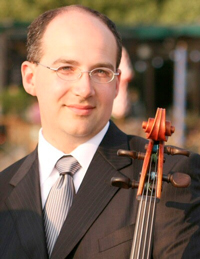by Nicholas Jones

Though there were no projected visuals to accompany this early “space music,” Cleveland’s NASA Glenn Research Station – many of whose employees were in attendance – installed a mock-up of the Mars rover and other astronomical displays near the entrance.
Holst’s suite, written over several years during and just after World War I, is actually less about the planets as NASA knows them than about their supposed astrological qualities. As in a baroque suite, each of the seven movements is a mood piece of its own. We encounter at each new turn a different affect – bellicose (Mars), delicate (Venus), officious (Mercury), expansive (Jupiter), exhausted (Saturn), bizarre (Uranus), and finally mystical (Neptune).
When Holst wrote, Pluto had yet to be given planet status, only to lose it to recent scientific revisionism. Earth, having no astrological significance, is not included.
Holst’s orchestration is distinctly late-nineteenth century, with echoes of Rimsky Korsakov and even Stravinsky. Musical character-writing abounds, taking full advantage of an enormous orchestra. Big “English” chords layered with octave doublings in divided strings and winds create a feeling of vast spaces. Chattering woodwinds, busy harps and celeste, and every imaginable piece of percussion fill the pieces with a constant sense of energy. Above all, big writing for a big brass section (more of an “English” sound?) fills the air and stirs the heart.
At the very center of the piece, in the famous “Jupiter” movement, is a hymn known later to Brits as “I vow to thee, my country.” It is unabashedly sentimental and unfailingly uplifting, and it was hard not to sing along.
The success of The Planets depends upon an orchestra of the extraordinary quality of Cleveland’s: the parts are difficult, the gestures are demanding (sudden crescendos, loud exposed passage-work), and the work is long and physically exhausting. The orchestra met the challenge beautifully.
Much credit needs to go to Tovey, who demonstrated utter conviction about the piece: he clearly knows it well, loves it, and does not shy away from its scope or its accessibility.
Unfortunately, there were moments of ensemble difficulties, particularly in the very ending where an offstage women’s chorus is to end the piece while the orchestra sits motionless (as Holst writes in the score, “until the sound is lost in the distance”). The chorus’a tuning on these exposed chords was not secure, nor was the diminuendo smooth – at one point they were singing, at another point they seem to have just stopped.
Before intermission, the orchestra presented two Cleveland orchestra premieres. The first was William Walton’s wartime Prelude and Fugue: The Spitfire, a concert version of the score for the 1942 film, The First of the Few, about the British plane that is said to have saved Britain. As in “Jupiter,” there is a big “hymn” tune and a rich English string sound.
The fugue, which in the film accompanied a scene of the factory where Spitfires were coming down the assembly line, is stirring if not sophisticated. In the middle is a beautiful lyrical section, featuring a violin solo (elegantly performed by concertmaster Peter Otto) that seemed to me to evoke a lone airplane soaring above the clouds.
Tovey is a genial and witty host, using the microphone to welcome and guide the audience. With understated British humor he told several jokes about Spitfires and violas, apparently invented for the occasion by the orchestra’s viola section. He also gave very helpful commentary on each of the pieces.
Samuel Barber’s Cello Concerto, premiered in 1946, deserves to be heard more, as Tovey said in his introduction. Like Barber’s more famous violin concerto, it is both technically dazzling and musically satisfying. The soloist was Cleveland’s principal cellist Mark Kosower, who played this demanding piece with apparent ease and complete musicality. Rapid double stops in thumb position and fiercely intricate runs into the highest registers (at one point, even beyond the fingerboard) were exciting counterparts to a rich, warm tone and an intelligent lyricism.
Throughout the piece, Barber insists upon the personality of the solo cello’s voice, conversing with the orchestra while also exploring its own journey. The writing is sometimes lyrical, sometimes dissonant and agitated. Listening to Kosower’s humane and expressive playing, I thought of the great American postwar poet Robert Lowell, whose poems alternately exposed the torments of that terrible period, and at the same time gave them form and meaning.
Especially profound was Barber’s second movement, a resonant andante sostenuto interweaving the solo cello with the principal oboe and three trumpets. It felt like a testament that beauty can be sustained even in tragic times.
Nicholas Jones is Professor of English at Oberlin College and a keen amateur musician.
Published on ClevelandClassical.com August 6, 2013
Clickhere for a printable version of this article.



